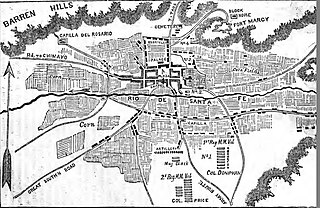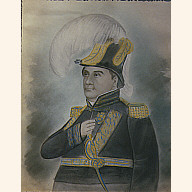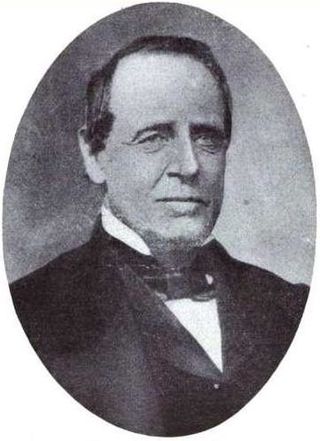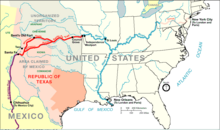
The Republic of Texas was a sovereign state in North America that existed from March 2, 1836, to February 19, 1846. It shared borders with Mexico, the Republic of the Rio Grande, and the United States of America.

Santa Fe de Nuevo México was a province of the Spanish Empire and New Spain, and later a territory of independent Mexico. The first capital was San Juan de los Caballeros from 1598 until 1610, and from 1610 onward the capital was La Villa Real de la Santa Fe de San Francisco de Asís.

The San Carlos Fortress is an 18th-century fortress in the city of Perote, in the Mexican state of Veracruz. It is also known as the Fort of San Carlos, Perote Castle, the Castle of San Carlos, Perote Prison, San Carlos de Perote Fortress, and San Carlos de Perote Castle.

The Santa Fe Trail was a 19th-century route through central North America that connected Franklin, Missouri, with Santa Fe, New Mexico. Pioneered in 1821 by William Becknell, who departed from the Boonslick region along the Missouri River, the trail served as a vital commercial highway until 1880, when the railroad arrived in Santa Fe. Santa Fe was near the end of El Camino Real de Tierra Adentro which carried trade from Mexico City. The trail was later incorporated into parts of the National Old Trails Road and U.S. Route 66.

The Capture of Santa Fe, also known as the Battle of Santa Fe or the Battle of Cañoncito, took place near Santa Fe, New Mexico, the capital of the Mexican Province of New Mexico, during the Mexican–American War on 8 August through 14 August 1846. No shots were fired during the capturing of Santa Fe.

Thomas Falconer was an English jurist and explorer.

Manuel Antonio Chaves or Chávez, known as El Leoncito, was a soldier in the Mexican Army and then became a rancher who lived in New Mexico. His life was full of incident, and his courage and marksmanship became literally legendary in his own time. In documented history, as an American soldier he helped win the American Civil War Battle of Glorieta Pass and was in command during an important fight in the Navajo Wars. As a Mexican soldier he probably negotiated the surrender of a large part of the Texan Santa Fe Expedition.
The Río Arriba Rebellion, also known as the Chimayó Rebellion, was an 1837 Pueblo-Hispano popular revolt in New Mexico which succeeded in briefly placing José María González and Pablo Montoya as governor of Mexico's Santa Fe de Nuevo México territory. González and Montoya were both Taos Pueblo Indians and led the independent Junta Popular or Cantón, which was the most ethnically inclusive government in the history of New Mexico. They remain the only Pueblo governors of New Mexico to this day.

Manuel Armijo was a New Mexican soldier and statesman who served three times as governor of New Mexico. He was instrumental in putting down the Revolt of 1837, he led the force that captured the Texan Santa Fe Expedition, and he later surrendered to the United States in the Mexican–American War, leading to the Capture of Santa Fe.

Henry Connelly was Governor of the New Mexico Territory during the American Civil War. He was appointed by President Lincoln and served from September 4, 1861, until July 6, 1866. During his term, the territory broke into two, and then three parts due to the Civil War and administrative problems.
This is a timeline of the Republic of Texas, spanning the time from the Texas Declaration of Independence from Mexico on March 2, 1836, up to the transfer of power to the State of Texas on February 19, 1846.

The Mier expedition was an unsuccessful military operation launched in November 1842 by a Texian militia against Mexican border settlements; it was related to the Somervell expedition. It included a major battle at Ciudad Mier on December 26 and 27, 1842, which the Mexicans won. The Texian attack was launched partly in hopes of financial gain and partly in retaliation for the Dawson Massacre earlier that year, in which thirty-six Texas militia were killed by the Mexican Army. Both conflicts were part of continuing efforts by each side to control the land between the Rio Grande and Nueces River. The Republic of Texas believed that the territory had been ceded to it in the Treaties of Velasco by which it gained independence, but Mexico did not agree. The expedition is best known for the Black Bean Episode, in which the Mexican Army decimated escaped prisoners, selecting for execution one in ten prisoners by drawing beans from a pot.

The Texan schooner San Antonio was a two-masted schooner of the Second Texas Navy from 1839-1840. She was the sister ship of the San Jacinto and the San Bernard. In 1840, San Antonio was part of the Texas Navy flotilla led by Commodore Edwin Ward Moore which was dispatched to assist Yucatecan rebels that had taken up arms against Mexico. In February 1842, while re-provisioning in New Orleans, the crew of the San Antonio mutinied and the Lieutenant was killed. This was the only mutiny in the history of the Texas Navy. That fall, the San Antonio sailed for Campeche and was never heard from again.
Guadalupe Miranda was a Mexican public official who was mayor of Ciudad Juárez and recipient of the 1,700,000-acre (6,900 km2) Beaubien-Miranda Land Grant.
George Wilkins Kendall (1809–1867) was a journalist, war correspondent, and pioneer Texas sheepman, known as the father of the Texas sheep business. Kendall County, Texas is named for him. In 1837, Kendall and Francis Lumsden established The New Orleans Picayune newspaper. By 1838, the paper had extended its coverage to the Republic of Texas. Kendall was given a Recorded Texas Historic Landmark in 1989, Marker number 2169, as a gravestone. During the Civil War, Kendall produced wool for Confederate uniforms and blankets.

Brigadier General Diego Archuleta, was a member of the Mexican Congress. He joined the Mexican Army to fight against the United States in the Mexican–American War. Later, he was appointed an Indian Agent by President Abraham Lincoln, and joined the Union Army during the American Civil War. Archuleta became the first Hispanic to reach the military rank of Brigadier General.
Manuel Álvarez was a Spanish-born Santa Fe trader who became lieutenant-governor of New Mexico.
José Mariano Chaves y Castillo was a wealthy Spanish-American landowner who was the acting governor of New Mexico for a few months during 1844. Chaves County, New Mexico is named after him.

William Gordon Cooke was a New Orleans druggist from Virginia, who volunteered for service in the Texas Revolution; fighting at Béxar and San Jacinto, he rose to the rank of major in the Texian Army. In the Republic he held a number of military and civilian appointments; as commissioner to the Comanches he participated in the Council House Fight, and as colonel of the First Texas Infantry he became the last commanding officer of the Regular Texas Army. After its disbandment, Cooke participated in the Santa Fe Expedition and sat imprisoned in Mexico City. Back in Texas, he fought the Mexicans at Arroyo Hondo, and in the naval battles of Campeche. The last Secretary of war of the Republic, he was also the State of Texas' first Adjutant general.

Texas raids on New Mexico in 1843 consisted of two expeditions sanctioned by the still independent country of Texas to raid Mexican commerce on the Santa Fe Trail and to assert control for Texas of New Mexico east of the Rio Grande, long inhabited by Hispanic settlers and Pueblo Indians. Both expeditions failed to do more than create apprehension by both the United States and Mexico that trade would be interrupted on the Santa Fe Trail. The Texans killed several Mexican traders along the trail and several civilians in a raid near the town of Mora, New Mexico. The Texans also killed or briefly took captive several Mexican soldiers.

















